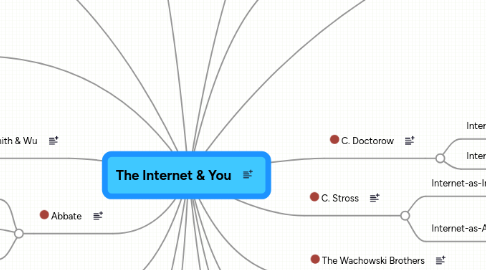
1. Kalathil & Boas
1.1. Policy
1.2. Global/Comparative
1.3. User focus
2. Internet Policy
2.1. Lessig
2.1.1. Controlling the Internet via Technological Means
2.1.2. Controlling the Internet via Sociological Means
2.1.3. Controlling the Internet via Lexicological Means
2.2. Kalathil & Boas
2.2.1. Controlling the Internet via Lexicological Means
2.2.2. Controlling the Internet via Technological Means
2.3. Goldsmith & Wu
2.3.1. Dealing with International Issues of Jurisdiction of the Internet
2.3.2. Controlling the Internet via Technological Means
2.3.3. Controlling the Internet via Lexicological Means
2.4. "Network Neutrality"
2.4.1. Markets Control Access
2.4.2. Consumer vs Business Access
2.4.3. Network focus
2.5. COPPA
2.6. DMCA
2.7. Copyright Extensions
3. Abbate
3.1. History
3.2. Social construction
3.3. User focus
4. Rheingold
4.1. History
4.2. Community focus
4.3. History-as-Narrative
5. Licklider & Taylor
5.1. Early pioneers of Network thinking
5.2. User Focus
5.3. Visionary
6. Goldsmith & Wu
6.1. History/Policy
6.2. Lexicological Focus
6.3. Market Focus
7. Speech Medium
7.1. Kalathil & Boas
7.2. Leads to Internet Policy
8. Communication Technology
8.1. Packet Switching, History of
8.2. Topological considerations
8.3. Development cycle of
9. Cyberculture
9.1. Rheingold
9.2. Gibson
9.3. Kitchen
10. Internet Communities
10.1. Annette Markham
10.2. Rheingold
10.3. Jane McGonigal
10.4. Internet "Authorities"
10.4.1. What constitutes Authority?
10.4.1.1. Financial Success
10.4.1.2. Critical Acclaim
10.4.1.3. Internet "Following"
10.4.2. Who do the Authorities tend to be?
10.4.2.1. Can Be Journalists
10.4.2.1.1. Dan Gillmor
10.4.2.2. Can Be Writers
10.4.2.2.1. Bruce Sterling
10.4.2.2.2. Neal Stephenson
10.4.2.2.3. Cory Doctorow
10.4.2.3. Can Be Architects
10.4.2.3.1. Vint Cerf
10.4.2.3.2. Tim Berners-Lee
10.4.2.3.3. Various Working Groups
10.4.2.3.4. ICANN
10.4.2.4. Can Be Businesspeople
10.4.2.4.1. Guy Kawasaki
10.4.2.4.2. Tim O'Reilly
10.4.2.5. Can Be Academics
10.4.2.5.1. Rheingold
10.4.2.6. Can Be Multiple (or None) of the Above
10.4.2.6.1. Bloggers
10.4.3. What does an Authority do?
10.4.3.1. Endorsement can increase authority of others
10.4.3.2. Their Buy-in can mean increased buy-ins of others
10.4.3.3. Their opinions steer others to make decisions of some sort
10.4.3.3.1. Purchase of service
10.4.3.3.2. Technological Change
10.4.3.3.3. Political Change
10.4.3.4. Attempt to influence policymakers
11. W. Gibson
11.1. Internet-as-Community
11.2. Internet-as-Place
11.3. Internet-as-Metaphor
12. N. Stephenson
12.1. Internet-as-Business-Market
12.2. The Network is the Technology
12.3. The Network brings forth its own Heroes
12.3.1. new archetypes: the Athenian Hero - The Engineer Geek
13. The Wachowski Brothers
13.1. The Matrix
13.1.1. Internet-Descendant as Control Medium
14. R. Heinlein
14.1. Moon is a Harsh Mistress
14.1.1. Networked Computer as Hero
15. C. Stross
15.1. Internet-as-Infrastructure
15.1.1. Pervasive and Ever-Present
15.1.2. Lack of Access = Lack of Resources
15.2. Internet-as-Attack-Vector
16. C. Doctorow
16.1. Internet-as-place-substitute
16.2. Internet-as-market
17. Internet-as-Market
17.1. eCommerce
17.2. New Methods of Delivery
17.3. A New Marketplace
17.4. Regulation concerns
17.4.1. How do you tax the internet?
